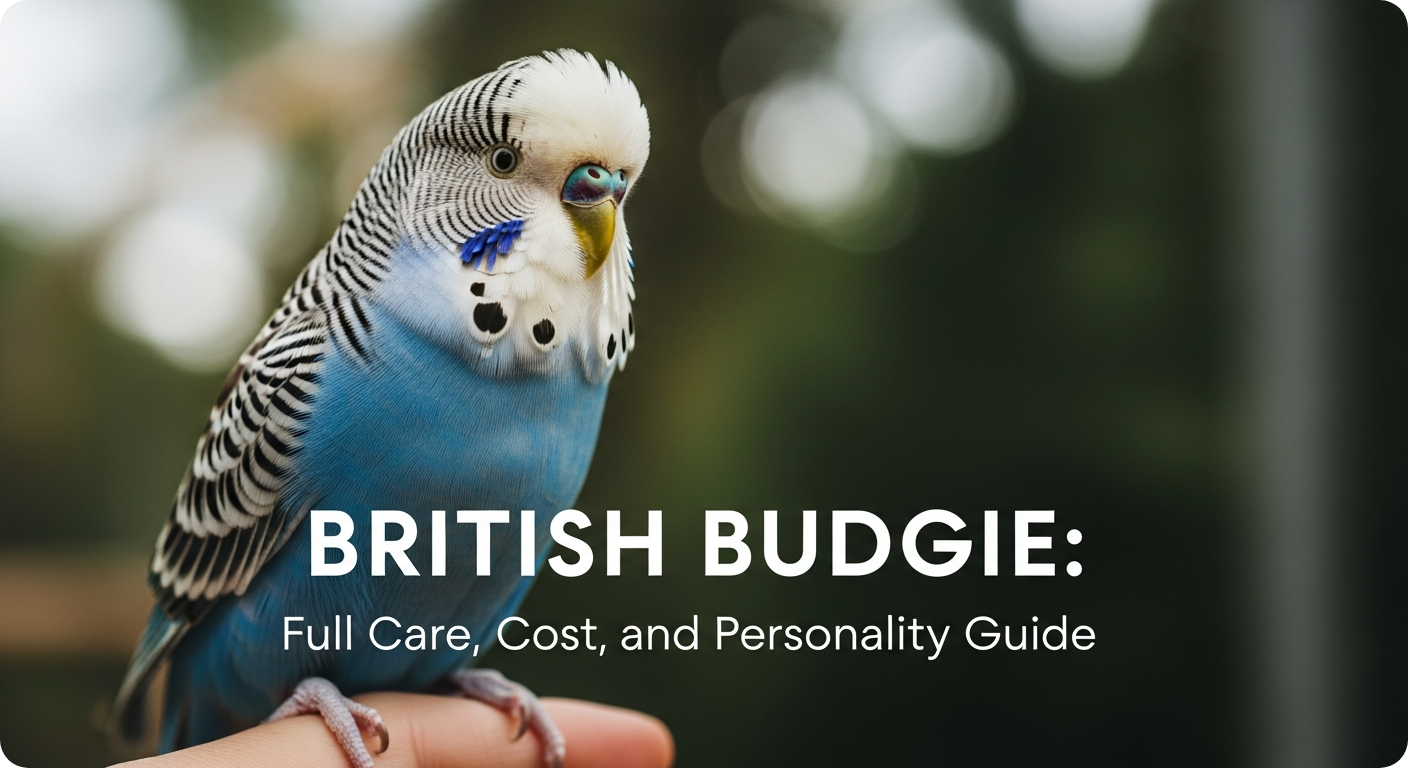

Introduction: Discovering the World of British Budgies
When you picture a budgie, what comes to mind? For most people, it’s a small, vibrant, and endlessly energetic little bird, zipping around its cage with cheerful chirps. This common image is typically of the American budgie, the type you’ll find in many pet stores across the globe. But there exists another, grander version of this beloved parrot—the British Budgie.
Often called the English Budgie or the Show Budgie, the British Budgie is a remarkable bird. It is the result of more than a hundred years of careful breeding in the United Kingdom. Breeders carried out this breeding not only for companionship but also for the competitive show ring.
Imagine the familiar budgie, but bigger, fluffier, and with a noticeably calmer and more dignified demeanor. The British Budgie is like the elegant, refined cousin of the everyday parakeet.
This comprehensive guide is your one-stop resource for everything related to British Budgies. Let’s explore their interesting origins first. Their beautiful appearance deserves a closer look as well. Finally, we’ll compare them to their American relatives.
We’ll answer all your pressing questions: Are British Budgies good pets? How much do British Budgies cost? And most importantly, how do you properly care for one of these feathered aristocrats? Prepare to learn everything you need to know about the magnificent British Budgie.
What Is a British Budgie? Complete Overview
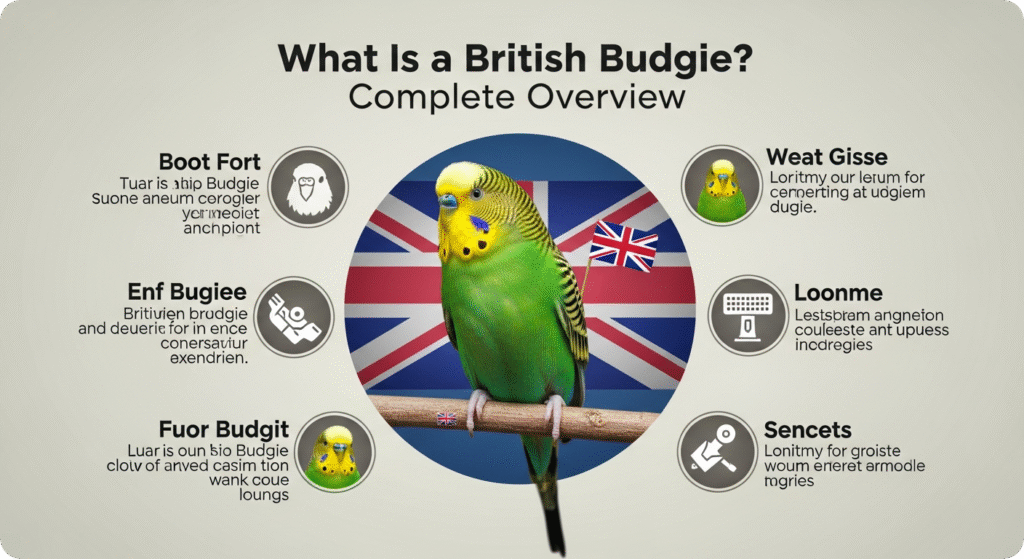
The British Budgie is not a separate species from the common budgerigar. Its scientific name is still Melopsittacus undulatus. The key difference lies in its genetics and breeding history.
The British Budgie is a special breed developed by bird keepers in the UK. It follows a strict “standard of perfection” for shows.
The Captivating Origins of British Budgies
The story of all budgies begins in the arid outback of Australia. The wild budgerigar is a small, quick bird. It is mostly green and yellow.
This bird is built for survival. It can fly fast to escape predators. It also travels around to find food and water.
In the early 1840s, English naturalist John Gould was fascinated by these small parrots. He brought the first live budgies to England. They became an instant sensation.
Their popularity exploded, and soon, bird enthusiasts and breeders began the process of selective breeding. Some breeders focused on creating new color mutations like blue, yellow, and grey. Meanwhile, a group in Britain selected birds for specific traits. They wanted larger size, broader heads, fluffier feathers, and stronger postures.
Each generation, they picked the biggest and most impressive birds to breed. This slowly changed the sleek, wild budgie into the beautiful British Budgie we see today. This was no accident of nature; it was a deliberate and artistic pursuit of an avian ideal.
The Striking Look of British Budgies
The appearance of a British Budgie is what truly sets it apart. Every aspect of its physique has been enhanced for visual impact.
- Size and Stature: The most immediate difference is size. A British Budgie is significantly larger than a standard American budgie.
- They typically measure between 7 to 10 inches from head to tail tip, but their bulk and posture make them appear even more substantial. They can weigh 45 to 65 grams, compared to the American budgie’s 30-40 grams. They stand taller and more upright, often appearing to “pose” naturally.
- The Head and Mask: The head of a British Budgie is broad, large, and domed, rising high above the beak. This gives them a wise and noble expression.
- Their “mask” (the area on the face) is large and clean, prominently displaying their round, dark throat spots. The most iconic feature is their long head feathers. These feathers create a beautiful “cap” or crest that flows over the back of the head.
- Feathers and Fluffiness: The plumage of a British Budgie is exceptionally dense and fluffy. The feathers are longer and softer, giving the bird a “full-bodied” and cuddly appearance. This fluffiness, known as “feather length,” is a key judging criterion in shows. When relaxed, a British Budgie can look like a soft, feathery puffball.
- A Kaleidoscope of Colors: Breeders have bred British Budgies for many years. They now show a wide range of colors and patterns.
- You can find beautiful types of birds beyond the basic greens, blues, yellows, and whites. These include Violets, Cinnamons, Greywings, Spangles, and Pieds. The combinations are nearly endless, making each British Budgie a unique work of living art.
British Budgie vs American Budgie: Comparison
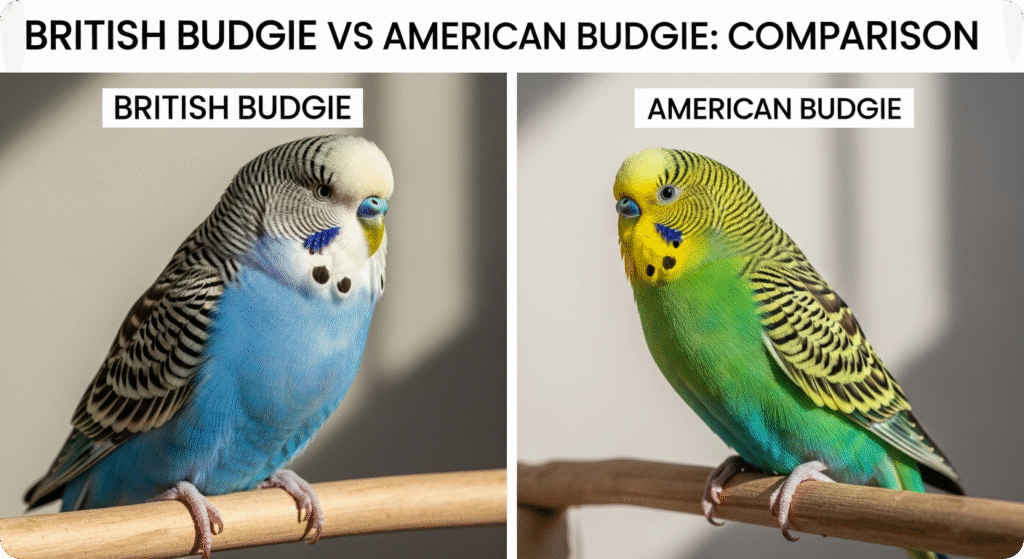
To fully appreciate the British Budgie, you need to see how it compares to the more common American budgie. This isn’t just a comparison of size; it’s a contrast in purpose, personality, and physiology.
British Budgie vs. American Budgie: A Detailed Side-by-Side Comparison
| Feature | British Budgie | American Budgie |
|---|---|---|
| Primary Purpose | Bred for exhibition and show | Bred primarily as a companion pet |
| Visual Appeal | ||
| Size & Weight | 7-10 inches, 45-65 grams | 6-8 inches, 30-40 grams |
| Head Shape | Large, broad, and domed | Smoother, flatter, and more streamlined |
| Body Posture | Upright, stocky, and “chesty” | Sleek, slender, and athletic |
| Feather Texture | Very fluffy, long feathers, “full-bodied” | Tighter, smoother feathers, sleeker look |
| Temperament & Behavior | ||
| Personality | Generally calmer, more docile, less hyper | Highly energetic, very active, often noisier |
| Activity Level | Lower; enjoys perching and observing | Very high; constant movement and play |
| Vocal Traits | ||
| Talking Ability | Can learn to talk, but often quieter/clearer | Excellent talkers, known for large vocabularies |
| Acquisition & Cost | ||
| Availability | Less common; typically from specialty breeders | Very common; found in most pet stores |
| Cost | Higher ($50 – $200+, depending on quality) | Lower ($20 – $50) |
British Budgie or Pet Budgie: Which Is Best?
The choice between a British Budgie and an American budgie depends entirely on your lifestyle and what you’re looking for in a feathered friend.
Choose a British Budgie if:
- You want a calmer, more sedentary bird that is content to sit with you.
- You are captivated by their impressive size and stunning, fluffy appearance.
- You are prepared to seek out a reputable breeder and potentially pay a higher price.
- You don’t mind a bird that may be less acrobatic and playful.
Choose an American Budgie if:
- You want a highly active, entertaining bird that is constantly on the move.
- Your priority is a bird with a high potential for learning to talk and mimic sounds.
- You want a readily available and more affordable pet.
- You enjoy the sleek, “wild-type” look of a traditional parakeet.
In summary, the British Budgie is a calm and beautiful bird. It is bred for its gentle nature.
The American Budgie is lively and playful. It is bred for its friendly personality and companionship. Both are wonderful in their own right, but they serve different roles in the world of bird-keeping.
The True Cost of British Budgies
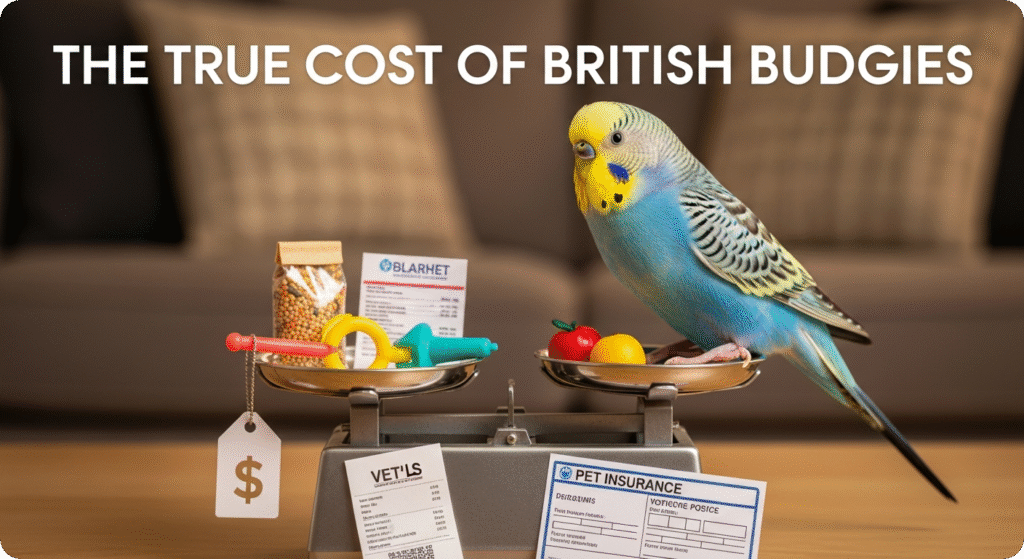
Bringing a British Budgie into your home is exciting. However, it is important to know the costs and effort needed to find a healthy bird.
Breaking Down the Cost of British Budgies
The price of a British Budgie can vary dramatically based on several factors.
- Pet-Quality British Budgies: These birds are healthy and make great pets. They may have small flaws, like a different color marking or posture, that would stop them from winning in a show. You can typically find these for $50 to $100.
- Show-Quality British Budgies: These birds come from champion bloodlines and adhere closely to the official show standards. They are bred specifically for competition and command a much higher price, often ranging from $150 to over $500.
- Factors Influencing Cost:
- Color and Rarity: Common colors like Light Green or Cobalt Blue are less expensive. Rare color mutations like Clearbody, Anthracite, or certain Pied patterns can significantly increase the cost.
- Age: Young, hand-tamed chicks are usually more expensive than older birds.
- Breeder Reputation: A well-known breeder with a history of producing champion birds will charge more.
Remember, the initial purchase price is just the beginning. You must also budget for:
- A Large Cage: A spacious cage suitable for a British Budgie can cost $100 – $300.
- Ongoing Supplies: High-quality pellets, fresh food, treats, toys, perches, and cuttlebones are recurring expenses.
- Veterinary Care: An initial check-up is essential, and you should have an emergency fund for potential illnesses. Avian veterinarians are specialized and their services can be costly.
The Rarity and Availability of British Budgies
You will not find a true British Budgie at your average chain pet store. Their specialized nature means they are less common and are primarily available through:
- Specialist Avian Breeders: This is the best and most reliable source. Look for breeders who are members of budgerigar societies.
- Bird Shows and Expositions: These events are excellent places to meet breeders, see their birds, and potentially purchase one.
- Online Classifieds and Bird Groups: Websites and social media groups for bird breeding can be helpful. However, always be careful and check the seller’s trustworthiness.
The rarity of British Budgies is part of their appeal. They are a niche pet for enthusiasts who appreciate the dedication and artistry behind their creation.
British Budgie: Complete Care Guide
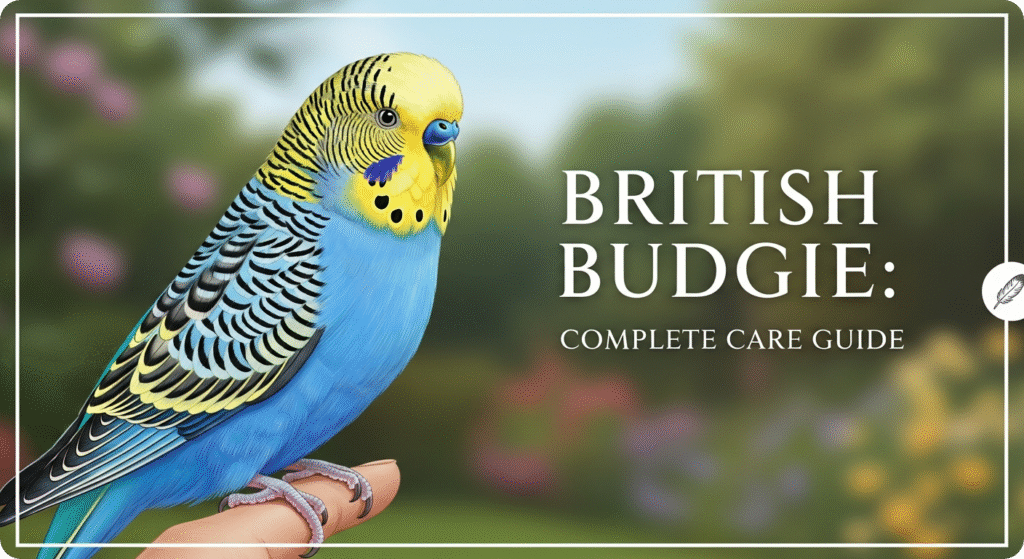
Providing excellent care for your British Budgie is essential for its well-being and longevity. With proper care, these birds can live for 7-12 years, sometimes even longer.
Creating the Perfect Home: Housing Your British Budgie
Due to their larger size, British Budgies require more spacious accommodations than their American counterparts.
- Cage Size: The absolute minimum cage size for a single British Budgie should be 24 inches long, 18 inches wide, and 24 inches tall. However, bigger is always better. A flight cage (longer than it is tall) is ideal as it allows room for short flights and exercise.
- Bar Spacing: To prevent injury, the bar spacing should be no wider than 1/2 inch.
- Cage Setup: Provide multiple perches of different diameters, textures, and materials (natural wood, rope, cement) to keep their feet healthy. Place food and water dishes at opposite ends of the cage from perches to keep them cleaner.
A Gourmet Diet: What to Feed Your British Budgie
A poor diet is a leading cause of health problems in pet birds. British Budgies thrive on a varied and nutritious diet.
- High-Quality Pellets: A premium, formulated pellet should make up about 60-70% of their daily diet. Pellets are designed to provide balanced nutrition.
- Fresh Vegetables and Greens: Offer a daily chop of fresh veggies. Favorites include dark leafy greens (kale, spinach), broccoli, carrots, bell peppers, and zucchini.
- Fruits and Treats: Fruits like apples, berries, and melon can be given in small amounts a few times a week as a treat. You should give millet spray sparingly, as it serves as the classic budgie treat—great for training and bonding.
- What to Avoid: Never feed avocado, chocolate, caffeine, or alcohol, as these are toxic to birds. Also, limit high-fat seeds; they are like junk food for budgies.
Health and Wellness: Keeping Your British Budgie in Top Condition
- Grooming: Your British Budgie will need occasional nail trims. Beak trimming is rarely needed if they have proper toys and perches to chew on. You can offer a shallow dish of water for bathing, or gently mist them with a spray bottle.
- Signs of a Healthy Bird: Bright, clear eyes; clean, smooth feathers; consistent droppings; active and alert behavior; a good appetite.
- Signs of Illness: Fluffed-up feathers for prolonged periods, lethargy, sitting on the cage floor, loss of appetite, wheezing or tail-bobbing while breathing, discharge from the eyes or nostrils. If you see any of these signs, contact an avian vet immediately.
The Art of Bonding and Building a Relationship with Your British Budgie
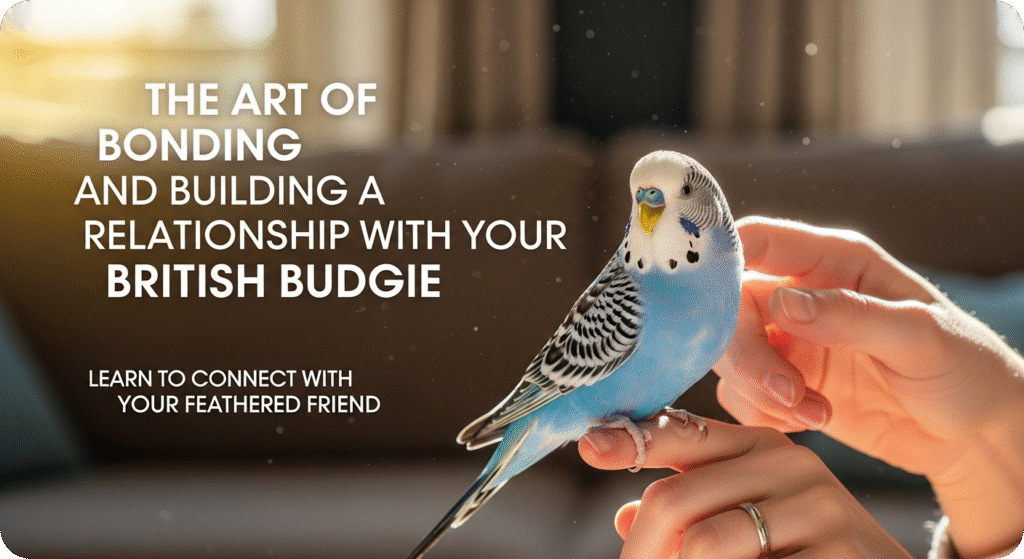
While British Budgies are known for their calm nature, building a strong bond with any bird requires patience, trust, and consistent positive interaction.
Step-by-Step Bonding with Your British Budgie
- The Adjustment Period: When you first bring your bird home, give it 2-3 days to adjust to its new environment without forcing interaction. Just talk to it softly from a distance.
- Building Trust with Food: Start by offering a special treat, like a piece of millet, through the cage bars. Once it takes the treat confidently, try offering it with the cage door open, allowing the bird to come to you.
- The “Step-Up” Command: This is the most fundamental command. Gently press your finger against the bird’s lower chest, just above its feet, and say “step-up.” The natural reaction is for the bird to step onto your finger. Reward it immediately with a treat and praise.
- Regular Out-of-Cage Time: Once your British Budgie is comfortable stepping up, allow it supervised time outside the cage daily in a safe, bird-proofed room. This is crucial for exercise and strengthening your bond.
- Social Interaction: British Budgies are social creatures. Spend time talking, reading, or just watching TV near their cage. The more they are included in your daily life, the more they will see you as part of their flock.
Understanding British Budgie Behavior
- Chirping and Singing: Content budgies will chirp and warble throughout the day. It’s a sign of a happy bird.
- Beak Grinding: A soft grinding sound means your bird is relaxed and content, often done before sleep.
- Fluffing Up: A quick fluff and shake is normal preening. If a bird is constantly puffed up, it may be cold or ill.
- Head Bobbing: This is a common behavior, especially in young birds, often indicating excitement or a desire to be fed.
With time and patience, your British Budgie will learn to trust you completely, leading to a deeply rewarding and affectionate friendship.
Frequently Asked Questions (FAQs) About British Budgies
Q1: Can British Budgies talk as well as American budgies?
A: Yes, British Budgies are fully capable of learning to talk and mimic sounds. However, they are often quieter and may have a clearer, though less extensive, vocabulary compared to the notoriously chatty American budgie. Their calmer nature sometimes translates to less constant chatter.
Q2: Is it okay to keep a single British Budgie, or do they need a friend?
A: British Budgies are social and can be kept alone, provided you can dedicate significant time (several hours daily) to interacting with them. If your household is busy, a same-species companion is highly recommended to prevent loneliness and boredom, which can lead to behavioral and health issues.
Q3: Are British Budgies harder to care for than regular budgies?
A: Their basic care needs are very similar. The main differences are that British Budgies require a slightly larger cage due to their size and may be more prone to obesity because of their less active nature, making a carefully managed diet even more important.
Q4: Why do some British Budgies have bald spots on their heads?
A: This is often related to their specialized breeding. The feather follicles on the heads of some color varieties (like Recessive Pieds) are not as dense, which can create a natural bald spot that is usually covered by surrounding feathers. However, baldness can also be a sign of mites, feather-plucking, or illness, so a vet check is wise if you’re concerned.
Q5: Where is the best place to buy a healthy British Budgie?
A: The best place is always a reputable, specialist breeder. Avoid pet stores and backyard breeders. A good breeder will be knowledgeable, keep their aviaries clean, and be happy to answer all your questions about the bird’s lineage and care.
Conclusion: Is a British Budgie the Right Pet for You?
The British Budgie is undeniably a magnificent bird. Its impressive size, regal posture, fluffy plumage, and gentle temperament make it a captivating pet for the right person. It is a living testament to the art of aviculture, a bird bred for beauty and companionship in equal measure.
However, choosing a British Budgie is a decision that should not be taken lightly. They require a significant commitment in terms of time, space, and financial resources. They are less common and often more expensive to acquire than standard budgies.
A British Budgie is right for you if:
- You are drawn to their calm and dignified personality.
- You have the space for a large cage and the time for daily social interaction.
- You appreciate avian beauty and are willing to seek out a quality breeder.
- You understand the ongoing costs and responsibilities of bird ownership.
You might want to reconsider a British Budgie if:
- You are looking for a low-cost, low-maintenance pet.
- You want a highly active, acrobatic bird that is constantly playing.
- You don’t have the time to dedicate to building a bond through patient, daily interaction.
In the end, welcoming a British Budgie into your life is about choosing a feathered companion, not just a decoration. If you can provide the care, commitment, and companionship these gentle giants deserve, you will be rewarded with a truly special and beautiful friend for years to come.

Leave a Reply